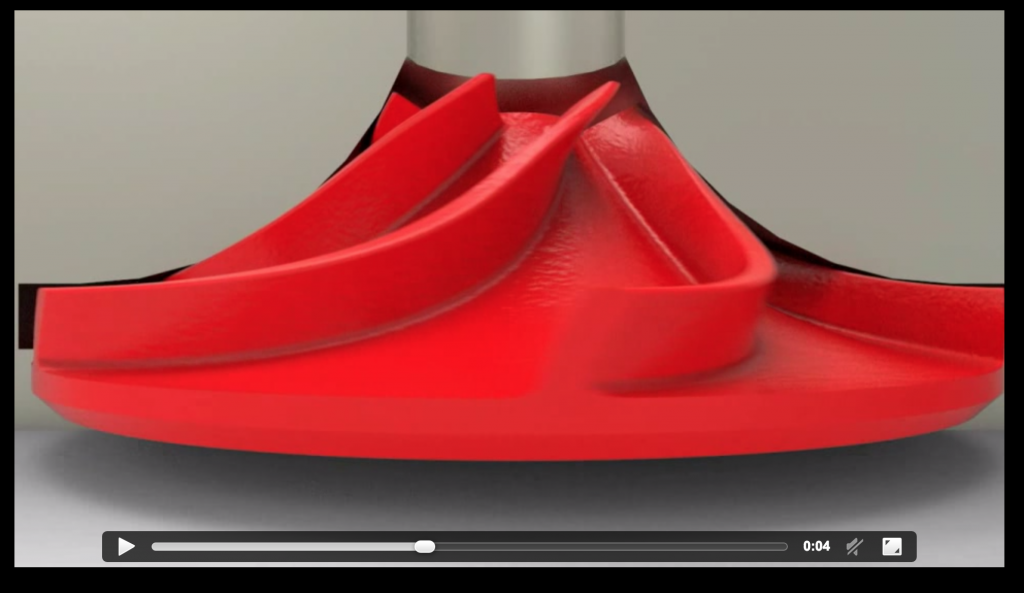An impeller is a rotor designed to modify the pressure and flow of a fluid, specifically to create a ‘sucking’ force. It is the counterpart to the more familiar propeller which creates a thrust force in liquid, commonly seen in the engines that move ships forward.
In other words, the impeller is used to create a pumping type of mechanism that operates through suction – so being told “your impeller sucks” is actually a compliment.
H enry Neilson, a fourth year mechanical engineering student at University College London, was tasked with creating a 3D printed hydro-impeller as part of a class project. And that’s when his professor told him that his design sucked, well, better than anybody else’s.
enry Neilson, a fourth year mechanical engineering student at University College London, was tasked with creating a 3D printed hydro-impeller as part of a class project. And that’s when his professor told him that his design sucked, well, better than anybody else’s.
In an interview with 3DPrint.com, Neilson explained his work:
“The impeller was part of a larger design project as part of a mechanical engineering degree design module. We were tasked with producing a design for an impeller that would fit a predefined casing and shaft assembly. The impeller in question was designed to work at 2700 RPM (this varied from person to person, from 2500 to 3200 RPM). Combining various fluid-dynamic, conservation of momentum and geometric equations, the impeller shown was chosen as a superior design.”
Neilson’s design employs a twisted blade–as opposed to the more commonly employed flat blade–and appeared on paper to be the best design, of a select group of six. After 3D printing and testing, it proved to be not only the best in the group but the best in the history of the impeller program, providing a maximum head of 110L/m and a maximum efficiency of 59.6%. The impeller was created in CATIA V5 using a combination of the GSD workbench and other more ubiquitous parts of the software with a goal of allowing the greatest throughput of water.
 As is often the case with projects such as this, there is more to the challenge of designing and making it than there is to the development of a particular practical application. Satisfied with his proof of concept he has turned his 3D printed impeller into a desktop decoration.
As is often the case with projects such as this, there is more to the challenge of designing and making it than there is to the development of a particular practical application. Satisfied with his proof of concept he has turned his 3D printed impeller into a desktop decoration.
“The impeller design has proved to be far superior to all others by meeting a bar of 60% efficiency (0 decimal places) that no other design under the same project has met,” he said. “The impeller will not be applied for a commercial or personal use but instead was more a proof of concept. However I do currently use it as an attachment for my desk lamp!”
Do you know of similar designs created by student engineers? Let us know about them, and your thoughts on this creation, in the 3D Printed Impeller forum thread over at 3DPB.com.
Subscribe to Our Email Newsletter
Stay up-to-date on all the latest news from the 3D printing industry and receive information and offers from third party vendors.
You May Also Like
NSF Awards Kentucky $1M for Advanced Manufacturing
The National Science Foundation has awarded a $1 million grant to the University of Louisville for the Advancing Manufacturing and Building Construction Technologies (NSF AMT) project. This initiative is part...
3D Printing News Briefs, May 11, 2024: 3D Printed Stent, Tower, Sculptures, & More
We’re starting off with medical research in today’s 3D Printing News Briefs, as researchers in Korea used CT images and 3D printing to fabricate an educational simulator for a mastoidectomy....
3D Printing Unpeeled: Wind Turbines, Probiotics and Lenses
TPI Composites, ORNL and Ingersoll Rand are working to make wind turbine tooling segments that can be 18.3 meters long. These elements also include resistive wires that help keep the...
Tethon 3D Releases Cost-effective Bioprinter
Tethon 3D, known for its ceramic-loaded DLP materials, custom resins, and DLP 3D printers, has recently released a bioprinter. Vat polymerization printers like DLP systems have been widely used by...
































